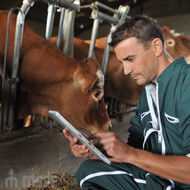Wireless Animal Immobilisers – Improving safety in the agricultural industry
Posted by MEFE on 28th Mar 2017

The most dangerous workplaces in Australia are farms. According to the Work Health and Safety in the Agricultural Industry 2016 report, almost a quarter (24 per cent) of agricultural employees’ serious claims involved animals, and the most common type was live, four-legged animals (87 per cent).
Cattle farmers, graziers and stock handlers have to perform a wide range of tasks under varying conditions in the course of a typical working day, and across the seasons. It's physically tough work, often undertaken alone, with some forces not under the farmer's control – like weather, or the behaviour of animals.
When considering these issues it is clear that a wireless, portable, weatherproof cattle immobiliser is an incredibly valuable tool to the industry.
- Electro-immobilisation
Electro-immobilisation was introduced in the form of a wired device – one clip to the ear or nose and one clip to the tail, connected to an external battery source delivered an electric current down the spinal column, resulting in temporary immobilisation.
The downside to this method is that wires can easily get tangled, stood on, and clips can slip or get pulled off, resulting in a suddenly unrestrained animal. Further problems occur as there are two probes or clips to be fitted, at opposite ends, before any effect is seen.
The development of a wireless, battery powered unit fulfils all the functions of traditional electro-immobilisation , with the added benefit of an all-in-one probe that is easily operated by a single user with little else required. There are no wires or external battery clips to contend with. One probe is inserted and the results are immediate
- How Does It Work?
The Immobiliser is powered by internal batteries as seen above. It is designed to immobilize an animal through the combination of a variable current and probe placement, utilizing the animal's natural nervous system to control the muscles and nerves. The probe is placed into the animal's anus and the gentle electrical signal is controlled with the control knob. As the electrical current is increased the animal will be increasingly immobilised until the entire animal is calm and completely immobile. The unit is designed so that cardiac and respiratory functions are not affected.
- Safety, Speed and Control
Potential injuries caused by animals to humans include bites, kicks, wounds from horns, being trampled, or being crushed or pinned.
Traditional methods of cattle restraint (e.g. cattle crush, rope restraint) do not guarantee safety – it is still possible for the beast to kick, bite or jerk, experience stress or injure itself.
Wireless electro-immobilisation can be used in conjunction with traditional methods of restraint to completely immobilise the animal in a humane and calming manner, greatly reducing risk of injury to animal and human.
When sharp or hot tools are utilised, such as during castration, de-horning or branding, immobilisation provides an extra level of safety and control over the procedure.
- Aiding In Slaughter
The immobiliser also has value in the abattoir, and particularly with ‘home kill’ or small-scale slaughter situations. The immobiliser may be instated in the moments before shackle and slaughter, preventing kicks and nervous reflex during/after stun/ exsanguination, and may reduce the effects of adrenaline and stress on the muscle. For stressed or wild animals, using the immobiliser may increase the likelihood of a clean shot and a quick humane kill.
- Veterinarians
Veterinarians find the wireless cattle immobiliser invaluable in a myriad of situations and procedures. During emergency procedures or with untamed animals that are difficult to handle, the immobiliser will afford a greater level of safety, stress reduction and allow the vet to work as quickly as possible.
Electro-immobilisation has been safely tested on pregnant animals with no effect on the unborn and no adverse effects to mother.
- Wild Game Management
The immobiliser is effectively used on all large wild game species from giraffe to all the large buck, hippo to elephant. Safely and calmly restrain and immobilize the wildest of animals without the use of drugs or force of any kind.
Electro-immobilisation is also effective on a variety of large animals, including:
Camels
Horses and donkeys
Buffalo
Llama and alpaca
All animals are different and internal nerve structure and anatomy will vary. Weight, muscle mass and water content are also factors that affect the efficacy. For this reason the operator should pay careful attention to the animal’s response when inserting, turning on, and adjusting the impulse of the instrument.
- Animal Welfare
It should be stressed that the immobiliser is not purported to be a pain relief tool, nor should electro-immobilisation be used in place of anaesthetic when anaesthetic is required. The operator should appreciate that the immobiliser will prevent the animal from responding to pain.
Indeed, there are many routine procedures that cattle farmers regularly carry out without anaesthetic – and have done so for centuries. Castration, tagging, branding and nose ringing are just a few examples. With this in mind, MEFE believes that the immobiliser is an advantageous tool when tranquillisers are not possible or practical.
MEFE recommends that the device should not be used for any longer than is necessary, the lowest setting of current should be selected, and the operator should be experienced in handling and observing cattle.
- Purchase Online
For more information on Mitchell's Cattle Immobiliser, click here. Buy online or enquire directly about bulk purchasing.
- References and Recommended Reading:
Safe Work Australia 2016. Work Health and Safety in the Agricultural Industry 2016.
Cattle Standards and Guidelines Writing Group February 2013. Cattle Standards And Guidelines – Electro-immobilisation – Discussion Paper. Cattle Electro-immobilisation discussion paper public consultation version 1.3.13

